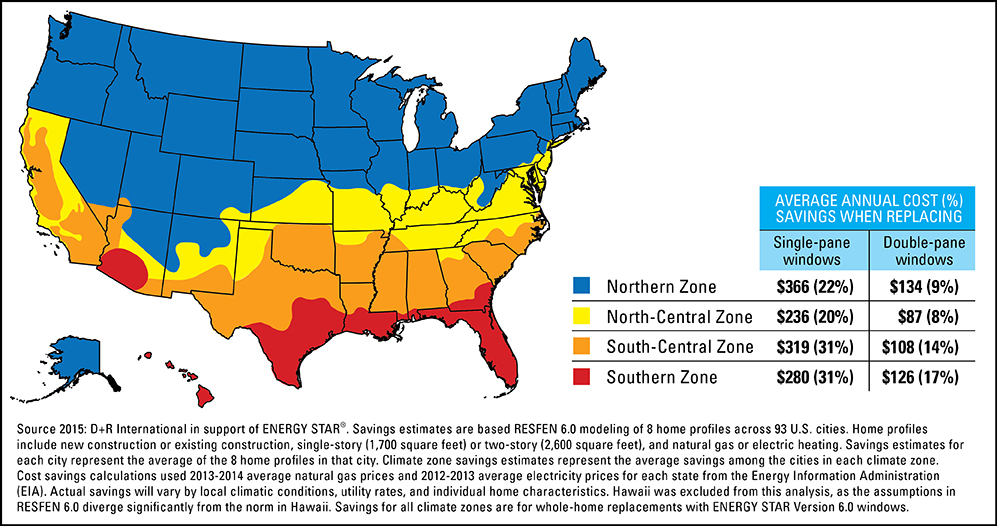Benefits of ENERGY STAR Qualified Windows, Doors, and Skylights
-
Save money — and more.
Installing ENERGY STAR certified windows, doors, and skylights lowers energy bills and saves you money. With more efficient windows, you also use less energy, which reduces greenhouse gas emissions from power plants. Feel your carbon footprint shrinking? -
Get comfortable.
Put an end to cold drafts and overheated spaces. ENERGY STAR certified windows, doors, and skylights keep your home’s temperature consistently comfortable. Even your loveseat right by the window can be cozy with ENERGY STAR. -
Protect your valuables.
Low-emissivity coatings on many ENERGY STAR certified windows, doors, and skylights reduces UV sun damage to floors, carpets, and furniture.
-
Certified Performance.
All ENERGY STAR windows, doors, and skylights are certified and verified to perform as labeled.
Save Money — and More. Choose ENERGY STAR Certified Products.
Installing ENERGY STAR certified windows, doors, and skylights can shrink energy bills — and carbon footprints — by an average of 12 percent nationwide, compared to non-certified products.
For typical homes, choose ENERGY STAR and save on average*:
|
$101–$583 which is equivalent to 51 to 317 gallons of gasoline |
a year when replacing single-pane windows |
|
$27–$197 which is equivalent to 13 to 102 |
a year when replacing double-pane, clear glass windows |
* Ranges are based on the average savings among homes in modeled cities. Actual savings will vary based on local climate conditions, utility rates, and individual home characteristics.
UPGRADE TO ENERGY STAR
ANNUAL SAVINGS1
Savings estimates are based on RESFEN 6.0 calculations performed by D&R International in support of ENERGY STAR. View methodology.
Get Comfortable
Comfort. It’s the essential quality of home. ENERGY STAR certified windows, doors and skylights do more than just lower energy bills — they deliver comfort that other products just can’t match.
PROTECTION FROM WINTER CHILLS
On cold winter nights, do you avoid seats near the window? The cold, inside surface of an inefficient window pulls heat away from your body, so you can feel chilly in a sweater with the thermostat at 70 degrees. With ENERGY STAR certified windows, the interior glass stays warmer, so you can enjoy your window seat even when the temperature outside dips well below freezing.
SHIELDING FROM SUMMER HEAT
Do some of your rooms feel like a sauna in the summer? A standard double-pane window allows approximately 75 percent of the sun’s heat into your home.1 With ENERGY STAR certified windows you can stay cool all summer long. Most ENERGY STAR certified windows reduce the “heat gain” into your home more than typical windows do, without reducing the visible light. You get the light you need without the uncomfortable heat.
1 Source: Residential Windows. Carmody, Selkowitz, Arasteh, and Heschong. 2007.
Protect Your Valuables
Drapes, wood floors, a favorite photograph: all these things can fade or discolor after repeated exposure to direct sunlight. Whether their value is monetary or sentimental, you want to protect your belongings from fading and discoloring.
ENERGY STAR certified windows have coatings that keep out the summer heat and act like sunscreen for your house, protecting your valuables from harmful, fading ultraviolet light without noticeably reducing visible light. These special coatings reduce fading by up to 75 percent.1
1 Source: Residential Windows. Carmody, Selkowitz, Arasteh, and Heschong. 2007.
What is a Carbon Footprint?
Your personal carbon footprint measures the carbon dioxide (CO2) emissions caused by your activities. It includes CO2 emissions from such things as driving your car or flying in a plane, the manufacture and distribution of the products you buy, and turning on the lights in your home. A carbon footprint is usually measured in pounds or tons of CO2 per year.
Home energy use accounts for about one-quarter of your carbon footprint, but this can vary depending on the kinds of energy sources available to power your home. ENERGY STAR calculates carbon savings for ENERGY STAR certified windows, doors and skylights based on the mix of fuels in a region and the estimated energy use for a typical home.

Sources:
EPA Power Profiler (fuel mix) www.epa.gov/cleanenergy/energy-and-you/how-clean.html. 2009.
Carbon Footprint, Ltd. Accessed at www.carbonfootprint.com/carbonfootprint.html. 2009.













